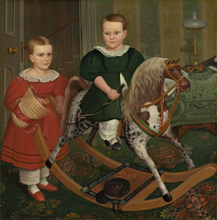Exhibition Press Release
Exhibition Checklist (PDF 134 KB)
Garbisch Collection Checklist
(PDF 72 KB)
Release Date: May 10, 2012
Deacon Robert Peckham's Recently Attributed Hobby Horse is Celebrated with Focus Exhibition of Children's Portraits at the National Gallery of Art, May 27–October 28, 2012

Robert Peckham, The Hobby Horse, c. 1840
oil on canvas
National Gallery of Art, Washington, Gift of Edgar William and Bernice Chrysler Garbisch
Washington, DC—One of the most intriguing and often-reproduced American paintings in the collection of the National Gallery of Art is the inspiration for Deacon Peckham's "Hobby Horse"—a focus exhibition on view on the Ground Floor of the East Building from May 27 through October 28, 2012.
"Peckham's Hobby Horse is one of the most beloved works in the Gallery's renowned American collection," said Earl A. Powell III, director, National Gallery of Art. "We are grateful to the American Folk Art Museum, the Colonial Williamsburg Foundation, the Fruitlands Museum, Historic New England, The Metropolitan Museum of Art, and the private collectors whose works help us to shed new light on the artist."
The exhibition is organized by the National Gallery of Art, Washington.
The Exhibition
When The Hobby Horse (c. 1840) was given to the Gallery in 1955 by Colonel Edgar William and Bernice Chrysler Garbisch, the artist's identity was unknown, but decades of research led to a formal attribution to Robert Peckham (1785–1877) in 2009. Along with this important painting, the exhibition brings together for the first time eight of the most vibrant and arresting of Peckham's portraits of children from four museums and several private collections. The subjects are from the families of Peckham's neighbors and community, a newly thriving class of Massachusetts merchants and manufacturers in the mid-1800s. A hide-covered, Boston-made rocking horse from the 1850s, similar to the one in the painting and lent by Historic New England, will also be included in the exhibition.
The portraits of children that Peckham made in the 1830s and 1840s are fewest in number, but certainly the most compelling of his works. Depicted sympathetically, with a striking sense of immediacy and no hint of Victorian sentimentality, his young subjects engage the viewer directly and intently. In works such as Rosa Heywood (c. 1840, Abby Aldrich Rockefeller Folk Art Museum, Williamsburg, Virginia), The Raymond Children (c. 1838, The Metropolitan Museum of Art, New York), and The Farwell Children (c. 1841, American Folk Art Museum, New York), the children are highlighted by a single source of light and tightly enveloped within the interiors or in corners of their homes, imparting a psychological intensity to their images.
These paintings also provide a detailed record of the costumes and furnishings of the time. Colorfully patterned carpets, wallpaper, fashionable tables, lamps, toys, and books reflect the growing affluence of antebellum New England as the economy expanded from agriculture into manufacturing.
To accompany the exhibition of works by Peckham, a selection of related works from the permanent collection are included in an adjacent gallery. These works are just a few of the more than 300 American naive paintings that were given to the Gallery by Colonel Edgar William and Bernice Chrysler Garbisch between 1953 and 1980. The Garbisches collected 18th- and 19th-century portraits, landscapes, still lifes, and other subjects by artists who were largely self taught. They acquired these bold works both for the visual pleasure they afforded and for the historical documentation of American life that they provided.
Deacon Robert Peckham
Peckham began his artistic career as an ornamental and sign painter. With only a few months training in portraiture, he carved out a long and successful career as a portrait artist. He lived and worked in Westminster, Massachusetts, and produced numerous vivid likenesses—more than 50 are attributed to him—of people from the town and nearby centers.
In addition to his painting career, Peckham was an important member of his community—a longtime deacon in his Congregational Church, a staunch abolitionist, ardent temperance advocate, and father of ten. He had a long and productive life (he died at 92) and was endowed with much of the same creative energy that allowed his entrepreneurial neighbors to prosper.
Curator and Related Offerings
The exhibition curator is Deborah Chotner, assistant curator, department of American and British paintings, National Gallery of Art.
Wilford W. Scott, head of adult programs, National Gallery of Art, will present 30-minute gallery talks on the exhibition. Tours begin at the Information Desk in the East Building Atrium at noon on June 5, 6, and 7, and at 1:00 p.m. on July 14, 17, and 19; September 28, 29, and 30; and October 1. More information and a full schedule of gallery talks are available at www.nga.gov/programs/galtalks.
A digital brochure will provide an essay discussing the context of Peckham's remarkable portraits of children, a chronology of the artist's life and list of his known works, and an illustrated catalogue of the works of art in the exhibition. The brochure will be available online, at the time of the exhibition's opening, at www.nga.gov/hobbyhorse.
Contact Us
For additional press information please call or send inquiries to:
Department of Communications
National Gallery of Art
2000B South Club Drive
Landover, MD 20785
phone: (202) 842-6353
e-mail: pressinfo@nga.gov
Newsletters
The Gallery also offers a broad range of newsletters for various interests. Follow this link to view the complete list.